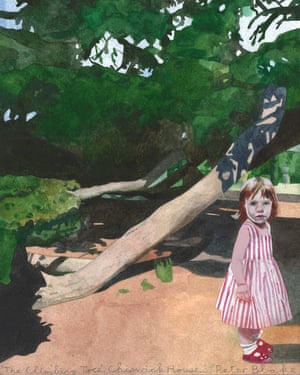Like the author JG Ballard, the artist Sir Peter Blake loved walking with his daughter in the gardens of Chiswick House. He wrote about it in 2018 in a feature for the Guardian Weekend, which was illustrated by the watercolour below, The Climbing Tree, Chiswick House. He later used the girl’s image in a print auctioned by Chiswick Auctions in aid of Chiswick House.
Peter Blake

I used to do this walk with my daughter Rose, after she was born 31 years ago. We’d start at the Chiswick High Road end of Duke’s Avenue. The trees that line this London street are a continuation of the avenue of trees in the gardens of Chiswick House. We would continue along the avenue until we came to the vast flower bed, a little way down and to the right. At one end of that is a slope, at the top of which stands a wonderful glass house of camellias, which were originally brought by boat from China in the 18th century. We’d go in there to see the famous collection of flowers and afterwards, once Rose could walk, she would always roll down the slope outside. We’d sometimes get a drink just in front of the house. Now, there’s a rather grand restaurant. Back then there was only a shack that sold soft drinks and a couple of Mars bars.
In those days the house wasn’t open to the public, as it is now. We would peep in sometimes; it was empty because they hadn’t decided what to do with it. Just in front there was, and still is, a cedar of Lebanon, planted in 1720 when William Kent designed the garden. We called it the climbing tree, and Rose would always want to clamber on to it. Then we would go through a little iron gate to say good morning to the goldfish in their tiny round pond. After that we’d feed the ducks on the big lake, and walk over the bridge towards the wild woodland part of the gardens, where the squirrels would come right up to you. Rose had particular favourites and gave them names. Then we’d pass the small pond with the Greek temple and sit opposite for a while with the squirrels. Eventually we’d walk back out and up Duke’s Avenue.
This watercolour took me about a week to do, combining a couple of photographs that my wife, Chrissy, took recently of the tree, with an earlier picture of Rose. I used a graphic design, rather than a painting technique: scanning the photographs to the size I wanted and then tracing them, so I had a basic drawing ready and could work into it with paint.
Watercolour is a difficult medium but incredibly satisfying when you get it right. The secret is to keep the paper as the white in the picture; so if you’re painting a face, and there’s a highlight somewhere, you try to paint all around it, keeping the white paper. There are different stages. I painted the sky first as a flat blue, then the branches against it. Then I added a thin blue glaze and painted up to it. You can wet the paper and put watercolour on, but it doesn’t dry the way it first goes on; it does stuff with the water. It’s magical.
Once I’m working from a photograph, any information comes from that. I remember the walk and I remember the tree, so there’s no need for me to go and see it. I’m 86 and lucky I’ve got a long-term memory. Once I decided this was the walk I wanted to paint, I just sat and recreated it in my mind and slowly it all came about
I hadn’t been back in recent years until last month, when Chrissy and I did that same walk to see Giffords Circus – only I’m in a wheelchair now. So there was a strange poignancy to be retracing our steps but with me, as it were, in the pram now.
Peter Blake is best known for his work using collage and advertising imagery, and exhibited alongside David Hockney in the early 1960s. Co-creator of the Sgt Pepper’s Lonely Hearts Club Band album cover in 1967, he was dubbed the “godfather” of British pop art. He was knighted in 2002, and has lived in Chiswick, west London, since 1967. His exhibition, Peter Blake: A Life in Drawings and Watercolours, runs until 8 September 2018 at Waddington Custot, London.
